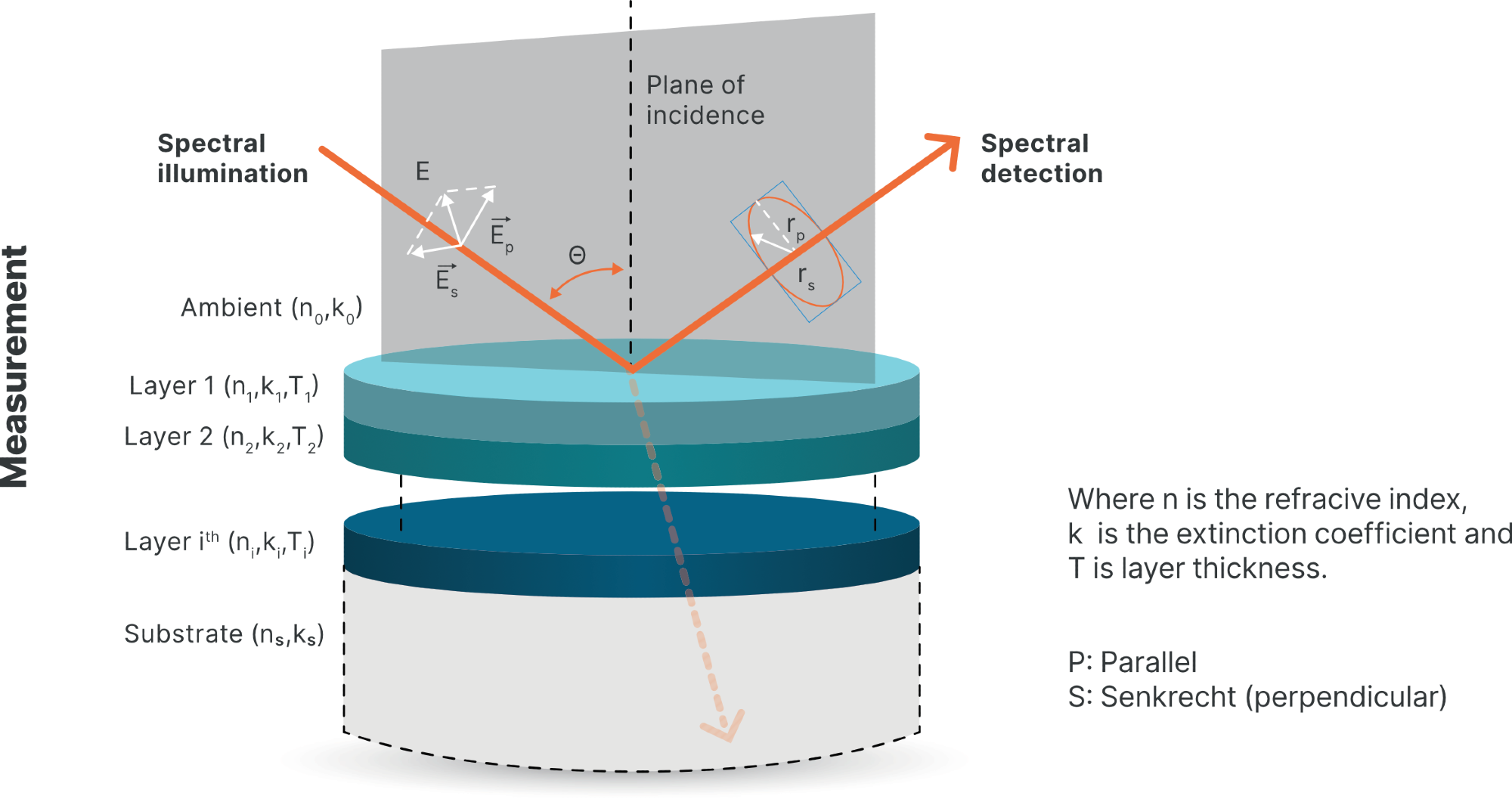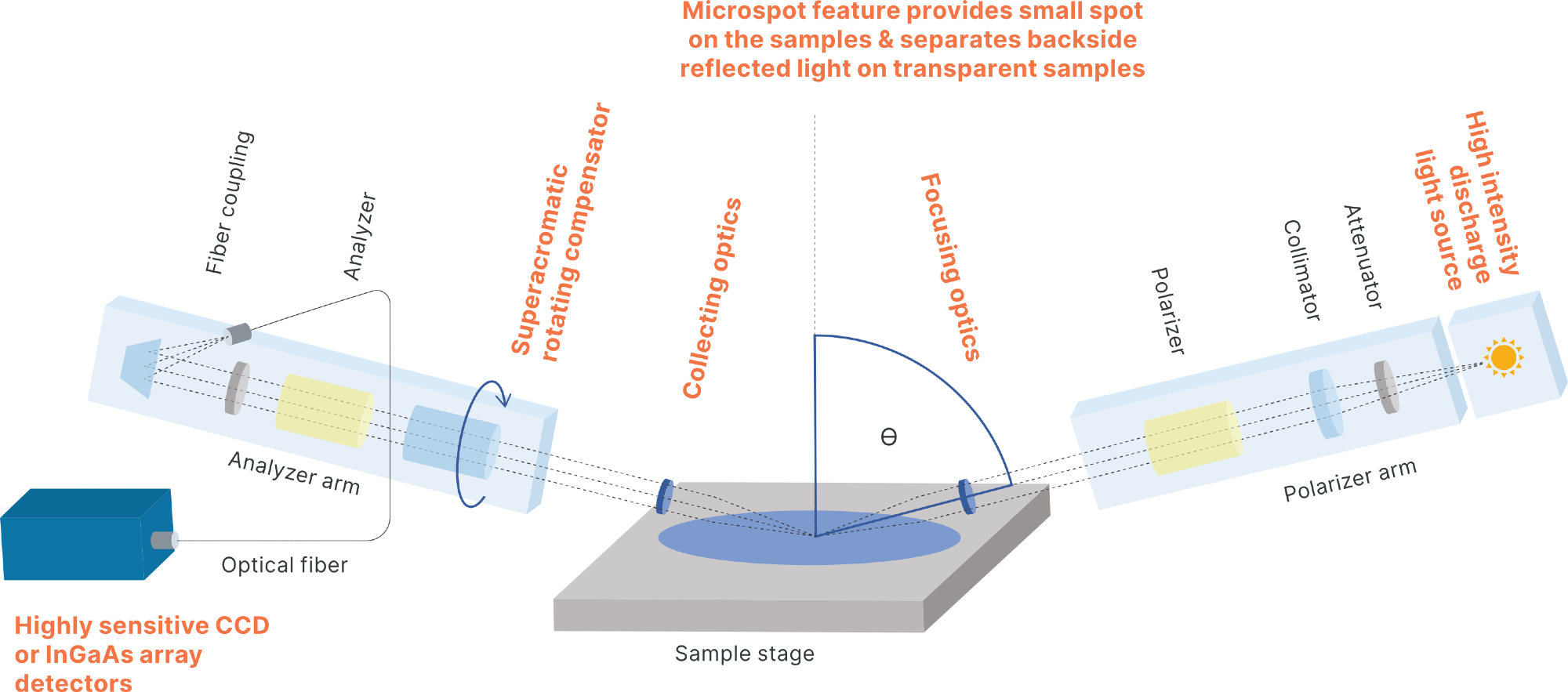Ellipsometry is a method for total optical measurement that is used to measure the change of polarization of light as it passes through a medium. During reflection, polarized light is distorted by the layer’s structure, allowing users to obtain information on the material properties of the medium present in the structure.
A number of techniques are available for establishing distorted polarization. Each of these employs different optical components to modulate the light polarization.
Semilab achieves this through the use of an advanced rotating compensator layout, whereby a high end broadband compensator is utilized to introduce variable phase shift. This phase shift will be dependent on the rotation angle, therefore allowing users to establish the ellipsometric elements spectrally.
Because ellipsometry is an indirect metrology, it is necessary to conduct modeling and parameter fitting for the actual structure in order to acquire values for the thickness and the refractive indices.
Semilab's Spectroscopic Ellipsometry Analyzer (SEA) software provides a diverse array of techniques suitable for creating models of these structures. It also offers powerful algorithms that are able to accurately fit model parameters in order to obtain the values of interest.

Image Credit: Semilab Semiconductor Physics Laboratory
Spectroscopic ellipsometry measurement offers a number of key benefits. Because it is an optical method, spectroscopic ellipsometry is non-contact and non-destructive. It enables the thickness and optical functions of each individual layer to be calculated when investigating a multilayer structure.
The method works by measuring the phase shift of a light beam traveling through a layer structure. Spectroscopic ellipsometry is a highly sensitive technique, and the phase angle measurement is not dependent on the absolute intensity of light.
Either white light sources or monochromators can be used to acquire spectral information on the sample.
Ellipsometry can be employed to measure ratios of complex Fresnel reflection coefficients. Because it is a complex number, it can be divided to an amplitude term and a phase shift term, corresponding to the ellipsometric angles, Ψ and Δ.
These parameters provide information on the layer structure’s physical properties, such as its thickness and refractive index.
Because this is a transcendental and extremely nonlinear equation, a model-based approach should be used to solve it using numerical techniques.
This procedure uses a model to consider the layer’s structure in terms of its thickness and optical functions. Relative phase shift is determined, and this is compared to measured quantities within a numerical regression process.

Image Credit: Semilab Semiconductor Physics Laboratory
Features
Using spectroscopic ellipsometry, it is possible to perform non-contact and non-destructive optical measurements on:
- Multilayer samples
- Single layer
- Substrates
This technique can be used to acquire parameters such as thin film thickness and optical properties.
Applications
Spectroscopic ellipsometry is useful in a wide range of applications and settings. These include:
- Semiconductors: silicon, thin dielectric films, very thin metal layers
- Optics
- Lighting
- Laser diodes
- Porous layers
- Photovoltaics
- Biological materials, liquids
- Organic layers / OLED, polymers, transparent conductive oxides
Measurement Modes
A number of measurement modes are available. These include:
- Transmission Ellipsometry for working with transparent substrates
- Generalized Ellipsometry for working with Anisotropic materials
- Spectroscopic Ellipsometry for working with thin film thickness and optical functions; for example, complex multilayer structures
- Porosimetry for measuring pore size and porosity in thin films
- Polarimetry
- Comparing Reflectance & Transmittance with wavelength and incidence angle
- In-situ measurement mode enables real-time control during etch or deposition processes
- Comparing Scatterometry with wavelength and angle of incidence
- Mueller Matrix (11 or 16 elements) can be used in combination with Scatterometry for working with 3D anisotropic materials
- Jones Matrix for working with simple anisotropic materials

This information has been sourced, reviewed and adapted from materials provided by Semilab Semiconductor Physics Laboratory.
For more information on this source, please visit Semilab Semiconductor Physics Laboratory.